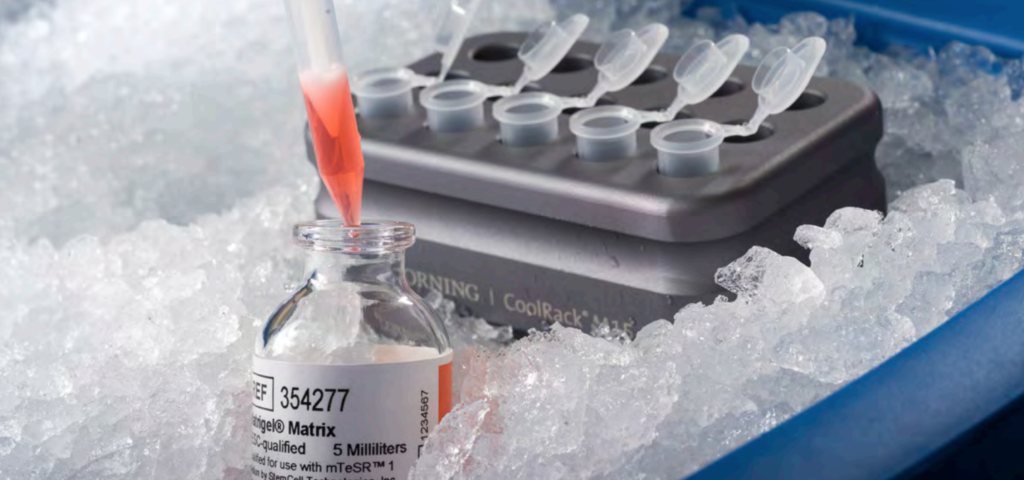Mouse models of malignant tumors called sarcomas have provided a fundamental tool for researchers to understand the pathology behind human cancers. However, it was not until the 1980s when researchers began looking for ways to grow mouse sarcoma cells and develop genetically manipulable mouse models that they became fully capable of examining the direct causes of many cancers in an in vivo setting. Around that time, material sciences and technology multinational Corning, developed Matrigel matrix, a solubilized basement membrane preparation extracted from the Engelbreth-Holm-Swarm (EHS) mouse sarcoma, a tumor rich in extracellular matrices (ECM) proteins, such as laminin, collagen IV, heparan sulfate proteoglycans, entactin/nidogen, Transforming growth factor-beta (TGF-ß), epidermal growth factor, insulin-like growth factor, fibroblast growth factor, tissue plasminogen activator, and other growth factors.
Today, 30 years later, this natural ECM-based hydrogel is widely used as a model for 2D and 3D cell culture in vitro, and together with 3D bioprinter manufacturer Allevi, they have created the first-ever protocol for bioprinting using Matrigel matrix called: ‘Allevi bioprinting protocol using Corning Matrigel matrix’.
From the development of several types of tumor cell invasion assays to exploring organoid model environments, from cancer and stem cell research to neurobiology, tissue engineers, biologists, and industry giants are using Matrigel matrix as a foundational biomaterial for diverse applications.
It has been tested for the ability to promote neurite outgrowth of chick dorsal root ganglia cells, in mouse colonies routinely screened for pathogens via Mouse Antibody Production (MAP) testing, in protein concentrations, and is very commonly used in cell growth and differentiation; metabolism and toxicology studies; invasion assays; in vitro and in vivo angiogenesis assays; in vivo angiogenesis studies and augmentation of tumors in immunosuppressed mice.
Since 2014, Allevi has turned into one of the companies leading the way in bioprinting thanks to its easy-to-use and cost-efficient bioprinters, software, as well as their broad understanding of cells. Years of experience taught them how to keep the cells alive during the printing process and what materials can help with this, like Corning Matrigel matrix. The company claimed that their 3D bioprinters are capable of printing high-quality bioinks without the need for viscosity agents that can hinder the ECM’s performance. They suggest that they engineered their patented CORE printheads to optimally print pure biomaterials, such as Matrigel matrix.
Moreover, Corning’s Matrigel matrix offers a network of proteins that provide the environment needed for optimal tissue performance, driving cellular responses such as proliferation and attachment. Allevi explained that Matrigel matrix has a unique formulation that, when used with Allevi bioprinters, allows users to create custom 3D tissues. Claiming that this is an optimal platform for cells to differentiate and behave more closely to how they would in the human body.
Matrigel matrix is a hydrogel that is rich in extracellular matrix proteins. The company behind it indicates that it has been successfully used for several 3D culture and tissue engineering applications. Now, it can also be used on the Allevi Platform to 3D bioprint cancer spheroids with a variety of cell lines. Furthermore, combining Matrigel matrix with Allevi 3D bioprinters can enable the automation of spheroid and organoid generation in a standardized and repeatable manner.
Allevi officials stated that “we can’t wait to see what you will do when you bioprint with Allevi and Matrigel matrix in your lab. It’s been 30 years of breakthroughs with Matrigel matrix, and we have a feeling that the pace of discovery is bound to quicken as we add another dimension to this bioink.”
The protocol developed clearly establishes that Matrigel matrix should be stored at -20˚C and that once removed from storage it needs to be thawed in an ice bucket at 4˚C overnight. Other indications include using an Allevi 5 mL Syringe, a syringe cap, a full metal 250 µm nozzle, and Costar Multi-well Plate or Falcon® Petri Dish.
Allevi is a company that understands the importance of teaming up to enhance the power of bioprinting. Last year they partnered with Xylyx Bio to create liver-specific bioinks, and previously with Made In Space for 3D bioprinting in orbit. This new protocol will help researchers and scientists make the best out of a combination of products that have a lot of potential for new trends in in vivo applications, virus testing, 3D cell culture research, and much more.
The post Allevi and Corning Present the First Protocol for Bioprinting With Matrigel appeared first on 3DPrint.com | The Voice of 3D Printing / Additive Manufacturing.


